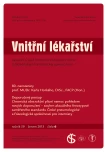The origins of the Czech Society of Cardiology and of Czech cardiology
Authors:
J. Widimský
Authors‘ workplace:
Klinika kardiologie IKEM Praha, přednosta prof. MU Dr. Josef Kautzner, CSc., FESC
Published in:
Vnitř Lék 2013; 59(6): 433-439
Category:
80th birthday prof. MUDr. Karla Horkého, DrSc., FACP (Hon.)
Overview
The paper presents the origins of the Czech Society of Cardiology on the one hand, and the origins of Czech cardiology on the other. The Czech Society of Cardiology is the third oldest in the world (after the American and German Societies). It was founded in 1929 by Prof. Libenský. As early as in 1933, the Society organised the first international congress of cardiologists in Prague, which was attended by 200 doctors, out of which 50 were from abroad. The most participants came from France and Poland. Other participants came from England, Argentina, Belgium, the Netherlands, Italy, Romania, Spain and Switzerland. The worldwide importance of this congress is apparent from the fact that both the World Society of Cardiology and the European Society of Cardiology (EKS) were founded after World War II in the years 1950 and 1952, i.e. almost 20 years after the first international congress of cardiology in Prague. In 1964, the Fourth Congress of European Society of Cardiology was held in Prague with the participation of 1,500 specialists from 31 countries and chaired by Prof. Pavel Lukl, the later president of EKS (1964 – 1968). The paper also presents the work of our specialists in WHO and the history of the international journal Cor et Vasa issued by the Avicenum publishing house in Prague in English and Russian in the years 1958 – 1992. An important role in the development of our cardiology was played by certain departments and clinics. In 1951, the Institute for Cardiovascular Research (ÚCHOK) was founded in Praha‑Krč, thanks to the initiative of MU Dr. František Kriegl, the Deputy Minister of Health. Its first director was Klement Weber, who published, as early as in 1929, a monograph on arrhythmias – 50 years earlier than arrhythmias started to be at the centre of attention of cardiologists. Klement Weber was one of the doctors of President T. G. Masaryk during his serious disease towards the end of his life. Jan Brod was the deputy of Klement Weber in the Institute and the chair of its Scientific Council. The Institute for Cardiovascular Research was the third institute for cardiovascular diseases in the world. The origins of Czech cardiology are documented in three most important areas – the treatment of hypertension, the development of cardiothoracic surgery and the development of treatment of acute myocardial infarction. Hradec Králové became, thanks to Academician Bedrna, the first centre of cardiac surgery in this country. The development of hypertension treatment was stormy, thanks to the discovery of an effective pharmacotherapy, from the originally incurable malignant hypertension to the well curable benign hypertension. The effective treatment of acute infarction was based on the development of heart defibrillation enabling the establishment of coronary units, and later on the thrombolytic and antiplatelet therapies up to the contemporary PCI as the treatment of choice. During that time, AIM mortality decreased from the original 30% to the present 4 – 5%.
Key words:
Czech Society of Cardiology – origins of Czech cardiology – treatment of hypertension – cardiothoracic surgery – treatment of acute myocardial infarction
Sources
1. Widimský J. 75. jubileum Československé a České kardiologické společnosti. Druhá nejstarší v Evropě a třetí nejstarší na světě. Cor Vasa 2004; 46 : 515 – 519.
2. Aschermann M, Widimský J. 80. výročí Československé a České kardiologické společnosti. Cor Vasa 2009; 51 : 664 – 669.
3. Klein O. Zur Bestimmung des zirkulatorischen Minutenvolumens nach dem Fickschen Prinzip. Münchener Medizinische Wochenschrift 1930; 77 : 1311 – 1312.
4. Widimský J. Otto Klein – the forgotten founder of diagnostic cardiac catheterization. Letters to the Editor. Eur Heart J 2008; 29 : 422 – 423.
5. Reiniš Z, Widimský J, Gvozdják I et al. The fiftieth anniversary of the Czechoslovak Society of Cardiology. Cor Vasa 1979; 21 : 445 – 449.
6. Widimský J. K sympoziu o plicní cirkulaci. Historie mezinárodních sympozií o plicní cirkulaci. Cor Vasa 1995; 37 : 33 – 37.
7. Brod J, Fejfar Z. The origin of oedema in heart failure. Quart J Med 1950; 19 : 187 – 237.
8. Brod J, Fejfar Z, Fejfarová MH. The role of neurohumoral factors in the genesis of renal hemodynamic changes in heart failure. Acta Med Scand 1954; 148 : 273 – 280.
9. Widimský J, Jirka J. Historie IKEM. Ústav pro choroby oběhu krevního. Čas Lék Čes 2002; 141 : 195 – 198.
10. Widimský J. Počátky kardiologie v Krči. Cor Vasa 2011; 53 : 6 – 13.
11. Widimský J. 50 let historie léčby hypertenze. Praha: Triton 2001.
12. Widimský J. Některé aspekty historie léčby esenciální hypertenze. 1. část. Vnitř Lék 2002; 48 : 62 – 70.
13. Widimský J. Některé aspekty historie léčby esenciální hypertenze. 2. část. Vnitř Lék 2002; 48 : 161 – 170.
14. Brod J. Essential hypertension. Haemodynamic observation with bearing on its pathogenesis. Lancet 1960; II: 773.
15. Widimský J, Uhlíř O. Postgraduální výchova lékařů v kardiologii (věnováno 30. výročí založení ILF). Vnitř Lék 1983; 29 : 493 – 500.
16. A cooperative trial in primary prevention of ischaemic heart disease using clofibrate: report from the Committee of Principal Investigators. Br Heart J 1978; 40 : 1060 – 1118.
Labels
Diabetology Endocrinology Internal medicineArticle was published in
Internal Medicine

2013 Issue 6
Most read in this issue
- Differential diagnosis and treatment of hyponatremia
- Impact of pregnancy on pituitary disorders
- Diuretics in monotherapy and in combination with other diuretics and non‑diuretics in the treatment of hypertension
- The environmental estrogen bisphenol A and its effects on the human organism
